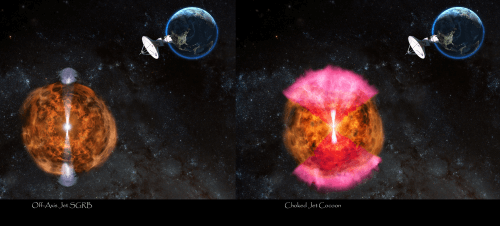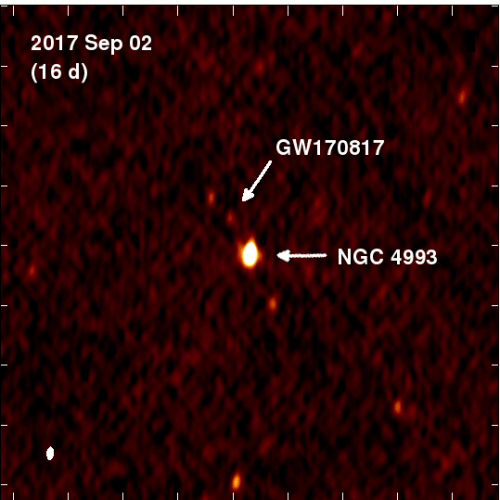In August of this year, gravitational waves and electromagnetic radiation were observed for the first time as a result of the merger of two neutron stars. The recording of the waves was made possible thanks to the "Lego" detector. Now, an international team of researchers, including Israeli researchers from the Hebrew University and Tel Aviv University, is revealing new radio observations that clarify what actually occurred during the collision.

The gravitational wave event, named GW170817, discovered last August (and was published during the month of October) is the first time that gravitational waves from the merger of neutron stars were observed and also the first time that electromagnetic radiation (almost in the entire spectrum including gamma radiation, X-ray radiation, ultraviolet light, visible light and radio radiation) accompanying a gravitational wave event was observed.
This event provided a rare opportunity to study the merger of neutron stars. For example, observations in the range of visible and infrared light provided evidence for the first time that there is indeed the creation of heavy elements in neutron star mergers (a process that was only predicted in theory until now). However, this event also provided new mysteries that have not yet been explored.
The prevailing theory is that in such a neutron star merger event, a lot of energy will be emitted in a focused and narrow beam (a narrow jet moving at a very high speed close to the speed of light). This jet is expected to penetrate the material around it, and when it is directed in our direction we expect to see gamma radiation. For years scientists have speculated that this is the model that explains short bursts of gamma rays observed every few weeks.
Indeed, about two seconds after the discovery of the gravitational waves, a short gamma radiation was also observed. However, the observed gamma radiation was not typical. It was very weak compared to other short bursts of gamma radiation observed so far (events without gravitational waves).
Scientists around the world tried to explain the weak radiation by saying that although a jet was created in the event, it is not directed directly at us but with a slight tilt. If this explanation is correct, then the theory tells us that we should see radio radiation now, several months after the initial detection, should be fading.

"It was clear to our team that conducting radio observations over several months would help solve the mystery," says Dr. Assaf Haresh, an experimental astrophysicist from the Hebrew University. Fortunately, radio observations can also be made during the day, and thus continue to collect data on astronomical events while they cannot be observed with other telescopes, such as optical telescopes," adds Dr. Haresh. Because over the last two months the position of the event GW170817 on the sky has become closer and closer to the Sun, leading to the cessation of observations at all wavelengths except the radio observations, at a time critical to data collection.
Now, the team of researchers who performed the radio observations claim that in the light of the new observations a jet was indeed formed, but it did not penetrate the material around it and therefore the observed radiation did not come from the jet itself, as was believed until now. The researchers found that the radio emission only got brighter for about 100 days after the initial detection, instead of fading away.
The radio observation indicates that the jet created in the event quickly lost its energy in favor of creating an envelope around it, in accordance with a theoretical model developed by Prof. Zvi Piren from the Hebrew University, and Prof. Ehud Necker and Uri Gottlieb from Tel Aviv University. This shell is a wide shell of material moving at a high speed, but lower than the speed of the jet itself. "In fact, the jet lost all its energy in favor of creating the envelope around it, which led to the jet itself apparently ceasing to exist in a short time," states Dr. Assaf Haresh.
The radio observations thus illuminate in a new light the model for the recently discovered gravitational wave event, because it is now clear that this event is not an event similar to a typical short burst of gamma radiation, and therefore the connection proposed in the past between the merger of neutron stars and short bursts of gamma radiation is far from proven.
On the other hand, we now know what the expected radio radiation is from the merger of neutron stars, so in the future scientists around the world will know what to look for in order to find more events of this type.
See more on the subject on the science website:
- The prediction from 1989 that came true and the rapid mobilization of astrophysicists to observe the source of gravitational waves with other detectors as well
- For the first time, a collision and merger of two neutron stars was observed
- Einstein - the man who started to take us out of the matrix: there are gravitational waves!
- Nobel Prize in Physics for the discovery of gravitational waves
